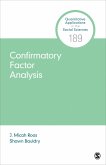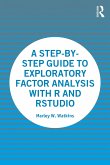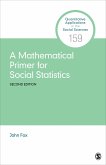Holmes Finch
Exploratory Factor Analysis
Holmes Finch
Exploratory Factor Analysis
- Broschiertes Buch
Andere Kunden interessierten sich auch für
![Confirmatory Factor Analysis Confirmatory Factor Analysis]() J. Micah Roos (Virginia Polytechnic Institute and State UniversityConfirmatory Factor Analysis55,99 €
J. Micah Roos (Virginia Polytechnic Institute and State UniversityConfirmatory Factor Analysis55,99 €![Individual Differences and Personality Individual Differences and Personality]() Colin CooperIndividual Differences and Personality73,99 €
Colin CooperIndividual Differences and Personality73,99 €![A Step-by-Step Guide to Exploratory Factor Analysis with R and RStudio A Step-by-Step Guide to Exploratory Factor Analysis with R and RStudio]() Marley WatkinsA Step-by-Step Guide to Exploratory Factor Analysis with R and RStudio69,99 €
Marley WatkinsA Step-by-Step Guide to Exploratory Factor Analysis with R and RStudio69,99 €![Social Network Analysis Social Network Analysis]() David KnokeSocial Network Analysis54,99 €
David KnokeSocial Network Analysis54,99 €![Event History and Survival Analysis Event History and Survival Analysis]() Paul D. AllisonEvent History and Survival Analysis42,99 €
Paul D. AllisonEvent History and Survival Analysis42,99 €![Generalized Linear Models for Bounded and Limited Quantitative Variables Generalized Linear Models for Bounded and Limited Quantitative Variables]() Michael SmithsonGeneralized Linear Models for Bounded and Limited Quantitative Variables54,99 €
Michael SmithsonGeneralized Linear Models for Bounded and Limited Quantitative Variables54,99 €![A Mathematical Primer for Social Statistics A Mathematical Primer for Social Statistics]() John Fox (Canada McMaster University)A Mathematical Primer for Social Statistics48,99 €
John Fox (Canada McMaster University)A Mathematical Primer for Social Statistics48,99 €-
-
-
Produktdetails
- Quantitative Applications in the Social Sciences
- Verlag: SAGE Publications Inc
- Seitenzahl: 144
- Erscheinungstermin: 3. Dezember 2019
- Englisch
- Abmessung: 212mm x 142mm x 12mm
- Gewicht: 17g
- ISBN-13: 9781544339887
- ISBN-10: 1544339887
- Artikelnr.: 57016174
Hinweis: Dieser Artikel kann nur an eine deutsche Lieferadresse ausgeliefert werden.
- Herstellerkennzeichnung
- Libri GmbH
- Europaallee 1
- 36244 Bad Hersfeld
- gpsr@libri.de
W. Holmes Finch (Ph.D. South Carolina) is the George and Frances Ball Distinguished Professor of Educational Psychology in the Department of Educational Psychology at Ball State University. Prior to coming to Ball State, he worked as a consultant in the Statistics Department at the University of South Carolina for 12 years advising faculty and graduate students on the appropriate statistical methods for their research. Dr. Finch teaches courses in statistical and research methodology as well as psychometrics and educational measurement. His research interests involve issues in psychometrics, including dimensionality assessment, differential item functioning, generalizability theory and unfolding models. In addition, he pursues research in multivariate statistics, particularly those involving nonparametric techniques. He is the co-author of Multilevel Modeling Using R (with Holden, J.E., & Kelley, K., CRC Press, 2014); Applied Psychometrics Using SAS (with French, B.F. & Immekus, J., Information Age, 2014); and Latent Variable Models in R (with French, B.F., Routledge, 2015).
Chapter One: Introduction to Factor Analysis
Latent and Observed Variables
The Importance of Theory in Doing Factor Analysis
Comparison of Exploratory and Confirmatory Factor Analysis
EFA and Other Multivariate Data Reduction Techniques
A Brief Word About Software
Outline of the Book
Chapter Two: Mathematical Underpinnings of Factor Analysis
Correlation and Covariance Matrices
The Common Factor Model
Correspondence Between the Factor Model and the Covariance Matrix
Eigenvalues
Error Variance and Communalities
Summary
Chapter Three: Methods of Factor Extraction in Exploratory Factor Analysis
Eigenvalues, Factor Loadings, and the Observed Correlation Matrix
Maximum Likelihood
Principal Axis Factoring
Principal Components Analysis
Principal Components Versus Factor Analysis
Other Factor Extraction Methods
Example
Summary
Chapter Four: Methods of Factor Rotation
Simple Structure
Orthogonal Versus Oblique Rotation Methods
Common Orthogonal Rotations
Common Oblique Rotations
Target Factor Rotation
Bifactor Rotation
Example
Deciding Which Rotation to Use
Summary
Appendix
Chapter Five: Methods for Determining the Number of Factors to Retain in
Exploratory Factor Analysis
Scree Plot and Eigenvalue Greater Than 1 Rule
Objective Methods Based on the Scree Plot
Eigenvalues and the Proportion of Variance Explained
Residual Correlation Matrix
Chi-Square Goodness of Fit Test for Maximum Likelihood
Parallel Analysis
Minimum Average Partial
Very Simple Structure
Example
Summary
Chapter Six: Final Issues in Factor Analysis
Proper Reporting Practices for Factor Analysis
Factor Scores
Power Analysis and A Priori Sample Size Determination
Dealing With Missing Data
Exploratory Structural Equation Modeling
Multilevel EFA
Summary
Latent and Observed Variables
The Importance of Theory in Doing Factor Analysis
Comparison of Exploratory and Confirmatory Factor Analysis
EFA and Other Multivariate Data Reduction Techniques
A Brief Word About Software
Outline of the Book
Chapter Two: Mathematical Underpinnings of Factor Analysis
Correlation and Covariance Matrices
The Common Factor Model
Correspondence Between the Factor Model and the Covariance Matrix
Eigenvalues
Error Variance and Communalities
Summary
Chapter Three: Methods of Factor Extraction in Exploratory Factor Analysis
Eigenvalues, Factor Loadings, and the Observed Correlation Matrix
Maximum Likelihood
Principal Axis Factoring
Principal Components Analysis
Principal Components Versus Factor Analysis
Other Factor Extraction Methods
Example
Summary
Chapter Four: Methods of Factor Rotation
Simple Structure
Orthogonal Versus Oblique Rotation Methods
Common Orthogonal Rotations
Common Oblique Rotations
Target Factor Rotation
Bifactor Rotation
Example
Deciding Which Rotation to Use
Summary
Appendix
Chapter Five: Methods for Determining the Number of Factors to Retain in
Exploratory Factor Analysis
Scree Plot and Eigenvalue Greater Than 1 Rule
Objective Methods Based on the Scree Plot
Eigenvalues and the Proportion of Variance Explained
Residual Correlation Matrix
Chi-Square Goodness of Fit Test for Maximum Likelihood
Parallel Analysis
Minimum Average Partial
Very Simple Structure
Example
Summary
Chapter Six: Final Issues in Factor Analysis
Proper Reporting Practices for Factor Analysis
Factor Scores
Power Analysis and A Priori Sample Size Determination
Dealing With Missing Data
Exploratory Structural Equation Modeling
Multilevel EFA
Summary
Chapter One: Introduction to Factor Analysis
Latent and Observed Variables
The Importance of Theory in Doing Factor Analysis
Comparison of Exploratory and Confirmatory Factor Analysis
EFA and Other Multivariate Data Reduction Techniques
A Brief Word About Software
Outline of the Book
Chapter Two: Mathematical Underpinnings of Factor Analysis
Correlation and Covariance Matrices
The Common Factor Model
Correspondence Between the Factor Model and the Covariance Matrix
Eigenvalues
Error Variance and Communalities
Summary
Chapter Three: Methods of Factor Extraction in Exploratory Factor Analysis
Eigenvalues, Factor Loadings, and the Observed Correlation Matrix
Maximum Likelihood
Principal Axis Factoring
Principal Components Analysis
Principal Components Versus Factor Analysis
Other Factor Extraction Methods
Example
Summary
Chapter Four: Methods of Factor Rotation
Simple Structure
Orthogonal Versus Oblique Rotation Methods
Common Orthogonal Rotations
Common Oblique Rotations
Target Factor Rotation
Bifactor Rotation
Example
Deciding Which Rotation to Use
Summary
Appendix
Chapter Five: Methods for Determining the Number of Factors to Retain in
Exploratory Factor Analysis
Scree Plot and Eigenvalue Greater Than 1 Rule
Objective Methods Based on the Scree Plot
Eigenvalues and the Proportion of Variance Explained
Residual Correlation Matrix
Chi-Square Goodness of Fit Test for Maximum Likelihood
Parallel Analysis
Minimum Average Partial
Very Simple Structure
Example
Summary
Chapter Six: Final Issues in Factor Analysis
Proper Reporting Practices for Factor Analysis
Factor Scores
Power Analysis and A Priori Sample Size Determination
Dealing With Missing Data
Exploratory Structural Equation Modeling
Multilevel EFA
Summary
Latent and Observed Variables
The Importance of Theory in Doing Factor Analysis
Comparison of Exploratory and Confirmatory Factor Analysis
EFA and Other Multivariate Data Reduction Techniques
A Brief Word About Software
Outline of the Book
Chapter Two: Mathematical Underpinnings of Factor Analysis
Correlation and Covariance Matrices
The Common Factor Model
Correspondence Between the Factor Model and the Covariance Matrix
Eigenvalues
Error Variance and Communalities
Summary
Chapter Three: Methods of Factor Extraction in Exploratory Factor Analysis
Eigenvalues, Factor Loadings, and the Observed Correlation Matrix
Maximum Likelihood
Principal Axis Factoring
Principal Components Analysis
Principal Components Versus Factor Analysis
Other Factor Extraction Methods
Example
Summary
Chapter Four: Methods of Factor Rotation
Simple Structure
Orthogonal Versus Oblique Rotation Methods
Common Orthogonal Rotations
Common Oblique Rotations
Target Factor Rotation
Bifactor Rotation
Example
Deciding Which Rotation to Use
Summary
Appendix
Chapter Five: Methods for Determining the Number of Factors to Retain in
Exploratory Factor Analysis
Scree Plot and Eigenvalue Greater Than 1 Rule
Objective Methods Based on the Scree Plot
Eigenvalues and the Proportion of Variance Explained
Residual Correlation Matrix
Chi-Square Goodness of Fit Test for Maximum Likelihood
Parallel Analysis
Minimum Average Partial
Very Simple Structure
Example
Summary
Chapter Six: Final Issues in Factor Analysis
Proper Reporting Practices for Factor Analysis
Factor Scores
Power Analysis and A Priori Sample Size Determination
Dealing With Missing Data
Exploratory Structural Equation Modeling
Multilevel EFA
Summary








